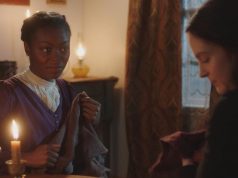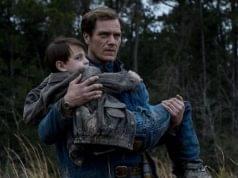If the first “Work and the Glory” film seemed stodgy and slow-moving, the sequel has taken measures to rectify that problem. “American Zion,” as it is called, has a new director, a new screenwriter, and a more streamlined approach to the epic-scope story.
Based on Volume 2 of Gerald N. Lund’s series of novels that place fictitious characters in the midst of real-life Mormon historical figures, “American Zion” picks up a few years after the first film left off, and includes a brief recap to bring newcomers up to speed.
In upstate New York in the early 1830s, the fictional Steed family has been divided by Mormonism, the new religion brought forth by local man Joseph Smith (Jonathan Scarfe). Benjamin Steed (Sam Hennings) is not a believer, but his wife Mary-Ann (Brenda Strong) is. Their adult sons, Nathan (Alexander Carroll) and Joshua (Eric Johnson), are also in disagreement about Joseph Smith’s divinity as a prophet, and what’s more, are in love with the same woman, a Mormon named Lydia (Sera Bastian).
At the beginning of the second film, Lydia and Nathan (a Mormon convert like his mother) are married by Joseph Smith himself. Joshua, meanwhile, has forsaken the family and the faith and moved to Independence, Mo., where he drinks, smokes and plays poker in a decidedly non-Mormon fashion. He hurriedly marries a girl there named Jessica (Emily Podleski) and instantly begins neglecting her.
Harassed by locals who don’t approve of any religion less than 200 years old, the Mormons begin an exodus to Kirtland, Ohio, where work on a temple commences even before a lot of the saints have proper houses to live in. Meanwhile, Joseph has his eye on Jackson County, Mo., as the site of a modern-day Zion — much to the consternation of Joshua Steed, of course, who moved to Missouri to get away from the Mormons, not to have them follow him.
More importantly, the new influx of Mormons — they are soon split between Ohio and Missouri — upsets Lt. Gov. Lilburn Boggs (R.D. Call), a frontier fatcat who, while smart enough not to get his own hands dirty in such escapades, encourages his cohorts to destroy a Mormon-owned printing press and drive the Mormons from their homes.
When word reaches Kirtland of the atrocities committed in Jackson County, the film reaches the meat of its story: Joseph leads a group of 200 men on a trip to Missouri, where they plan to reclaim — by force, if necessary — the saints’ homes and lands, which they have every legal right to inhabit. Nathan and Benjamin Steed are in Joseph’s group — the latter because he is sympathetic to a just cause, not because he’s a believer in Mormonism — and a face-off between them and their wayward Joshua is inevitable.
The new director brought in for this and the next sequel (filmed at the same time as “American Zion” and due out a year from now) is Sterling Van Wagenen, a seasoned producer and Brigham Young University graduate who co-founded the Sundance Film Festival. He directs “American Zion” in the style of the old epics — not in its length (it’s only 100 minutes), but in its tone, which is often formal and emotionally distant. The movie is shot and edited somewhat dispassionately, so that even when exciting things happen, they seem low-key. (The scene where Joseph is tarred and feathered is especially half-hearted, so mild it doesn’t even hint at the real pain and terror that accompanied such a punishment.) More close-ups, more angles and more urgency in the editing would have helped — but then the film would have seemed very modern, rather than old-fashioned, which I gather was the intent.
What Van Wagenen gets right, though, is the overall pace of the film, which is not sluggish and labored the way its predecessor was. Certain scenes may lack “zip,” yes, but the movie as a whole is agile and accomplished, and the performances are uniformly good, even among one-line characters.
Matt Whitaker is responsible for the adaptation (he previously co-wrote the stellar “Saints and Soldiers”), and he does well to focus less on internal spiritual angst, which the first film had in spades and which plays well in books but not in a visual medium like film, and more on a narrative that movie-goers can relate to: family rivalries, unjust persecutions, and good ol’ heroes and villains. A few points of early Mormon history are included out of obligation, but for the most part the movie focuses on what’s relevant to the story at hand
The character of Joseph Smith is much more integral to the plot than he was last time, and they were wise to keep the very talented Jonathan Scarfe around to play him. Portraying a man revered by millions as a prophet is no easy task. If you give him too many flaws, it’s disrespectful; if you make him a superman, he doesn’t seem real. Scarfe walks the line well, though there are times when Joseph comes across as a little smug, in my estimation, which does not seem to have been among his real-life shortcomings. Still, he’s the most fascinating character in the film, played with mystery and charisma by Scarfe, and I’d like to have seen more of him. There are hints that he’s uncomfortable with the mantle of “prophet,” that he’s awestruck and even frightened by the influence he has over people — yet that he must bear all of this as part of his calling as God’s mouthpiece, which he truly believes to be the case.
Most of the Steed family is in the periphery; only Benjamin, Joshua and Nathan are central figures. It’s Benjamin, played again with craggy uprightness by Sam Hennings, who is really the film’s religiously stubborn (but spiritually decent) protagonist. Fittingly, a late scene between Benjamin and Joseph is the movie’s pivotal moment, thematically speaking: Those two men, while differing in their religious views, are both so overwhelmingly GOOD that they ought to be blood brothers.
It all culminates in a fiery, thrilling finale (in which Sam Cardon’s ominous and shrieking musical score plays a key role) that ends with something of a cliffhanger — and if the previous scenes of important action had had this kind of energy to them, the movie would have been an unqualified success. As it stands, it’s a good movie, if not a great one, and that cliffhanger suggests some tantalizing prospects for Part 3.
B (1 hr., 40 min.; )




